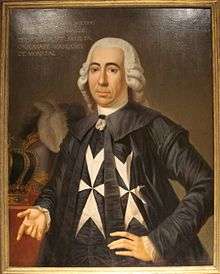Emmanuel de Rohan-Polduc
| Emmanuel de Rohan-Polduc | |
|---|---|
 | |
| Grand Master of the Order of Saint John | |
|
In office 12 November 1775 – 14 July 1797 | |
| Preceded by | Francisco Ximenes de Texada |
| Succeeded by | Ferdinand von Hompesch zu Bolheim |
| Personal details | |
| Born |
18 April 1725 la Mancha, Spain |
| Died |
14 July 1797 (aged 72) Valletta, Malta |
| Resting place | St. John's Co-Cathedral, Valletta |
| Nationality | French |
| Military service | |
| Allegiance |
|
Fra' Emmanuel de Rohan-Polduc (18 April 1725, in la Mancha, Spain – 14 July 1797, in Valletta, Malta) was a member of the wealthy and influential Rohan family of France, and 70th Prince and Grand Master of the Order of St. John from 1775 to 1797.
De Rohan was born in la Mancha, Spain on 18 April 1725. His father was French, but had been banished to Spain. He served in the courts of Madrid and Parma, before becoming an ambassador to Francis I. He eventually joined the Order of St. John, and served in several posts. He was considered as a potential successor to Grand Master Manuel Pinto da Fonseca following his death in 1773, but Francisco Ximenes de Texada was elected instead. Ximenes' magistracy was unpopular due to the Order's bankruptcy. He died in 1775, and was succeeded by De Rohan.[1]

De Rohan sought to win the respect of the people, and he became a popular Grand Master. On 21 June 1777, he elevated the village of Żebbuġ to the status of city, naming it Città Rohan. An archway commemorating this event was constructed in 1798.[2] The coat of arms of Żebbuġ contains the arms of the House of Rohan, in honour of the Grand Master.[3]
De Rohan authored the Code de Rohan, a constitutional law book published in two volumes titled Saint John of Jerusalem of Rhodes of Malta in 1782. This Grand Master was also responsible for the publication of the Diritto Municipale in 1784.[1][4]
De Rohan instituted the Anglo-Bavarian langue, which was housed in the former Palazzo Carniero. In 1797, he established the Russian Grand Priory, which later evolved into the Russian tradition of the Knights Hospitaller.[1]
In 1792, he commissioned and partially financed the construction of Fort Tigné.[5] St. Lucian Tower & Battery were also upgraded during De Rohan's magistracy, and the complex was renamed Fort Rohan in 1795 after the Grand Master. It was rebuilt as Fort San Lucian in the 1870s, but it still retains De Rohan's coat of arms on the façade.[6]
The last few years of De Rohan's magistracy were troublesome, due to the decline of the Order because of the French Revolution. De Rohan suffered a stroke in 1792, and his health began to deteriorate. He died on 14 July 1797, and was buried at St. John's Co-Cathedral in Valletta. His last words were "I, at any rate, am the last grandmaster, at least of an order illustrious and independent." He was proven correct, since less than a year after his death, the French invaded Malta and expelled the Order from the island.[1]
References
- 1 2 3 4 "Emmanuel de Rohan (1775-1797)". Haz-Zebbug.com. Retrieved 6 September 2015.
- ↑ "The De Rohan Arch". Haz-Zebbug.com. Retrieved 6 September 2015.
- ↑ "City of Ħaż Żebbuġ (Malta Island) (Malta)". crwflags.com. Retrieved 6 September 2015.
- ↑ Morana, Martin (2011). Bejn Kliem u Storja (in Maltese). Malta: Books Distributors Limited. ISBN 978-99957-0137-6. Archived from the original on 5 October 2016.
- ↑ Spiteri, Stephen C. (2011). "Fort Tigné 1792". Arx - International Journal of Military Architecture and Fortification (1): 20. Retrieved 6 September 2015.
- ↑ "Fort San Luċjan" (PDF). National Inventory of the Cultural Property of the Maltese Islands. 16 December 2011. Retrieved 6 September 2015.
External links
| Wikimedia Commons has media related to Emmanuel de Rohan-Polduc (GM 70). |
| Preceded by Francisco Ximenes de Texada |
Grand Master of the Knights Hospitaller 1775–1797 |
Succeeded by Ferdinand von Hompesch zu Bolheim |